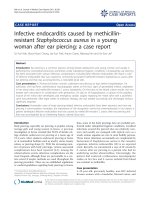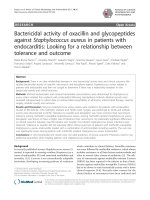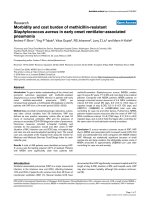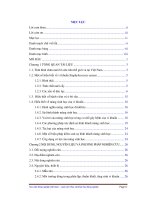Prevalence of staphylococcus aureus in bulk tank milk collected from Dairies of district Allahabad, India
Bạn đang xem bản rút gọn của tài liệu. Xem và tải ngay bản đầy đủ của tài liệu tại đây (193.84 KB, 7 trang )
Int.J.Curr.Microbiol.App.Sci (2017) 6(6): 1297-1303
International Journal of Current Microbiology and Applied Sciences
ISSN: 2319-7706 Volume 6 Number 6 (2017) pp. 1297-1303
Journal homepage:
Short Communications
/>
Prevalence of Staphylococcus aureus in Bulk Tank
Milk Collected from Dairies of District Allahabad, India
Renu Chaturvedi and Yashab Kumar*
Department of Industrial Microbiology, Jacob Institute of Biotecnology and
Bioengineering, Sam Higginbottom University of Agriculture,
Technology and Sciences, Allahabad-211007, India
*Corresponding author
ABSTRACT
Keywords
Antibiotic
Susceptibility test,
Staphylococcus
aureus, Dairy Milk,
Antibiotic Residue,
TLC.
Article Info
Accepted:
19 May 2017
Available Online:
10 June 2017
A study was carried out to evaluate the antibiotic sensitivity of Staphylococcus aureus
isolated from different raw milk samples. Isolation and identification of S. aureus
were done from 5 types of dairies raw milk samples. A total of 125 milk samples from
dairies were cultured for incidence of S. aureus. S. aureus was isolated from a total of
4 (3.2%) of the 125 milk samples. The antibiotic susceptibility pattern of S. aureus
isolated from different raw milk samples was performed. Staphylococcus aureus
strains were found to be susceptible, intermediate and resistant against different
antibiotics. Strain1 was found to be susceptible against gentamycin and cotrimoxazole,
intermediate against chloramphenicol, tetracycline and cephalothin, and resistant
against ampicillin and methicillin. strain2, starin3 and strain4 were found to be
susceptible against Gentamycin, Chloramphenicol and tetracycline, and Resistant
against Ampicillin, Methicillin, Cotrimoxazole and Cephalothin. The present study
provides preliminary information on incidence of antibiotic sensitive S. aureus as milk
contaminates. The antibiotic residue in raw milk samples were analyzed in terms of
Ampicillin by using TLC. According to the total number of 125 samples analysed, the
ratio of contamination with antibiotics was detected as 0.8%.
Introduction
Sufficient evidence exists to effect that milk is
an excellent source of nutrients for both man
(Sharma and Joshi, 1992) and bacteria (Henry
and Newlander, 1997). It is therefore required
that milk be consumed only after it is
pasteurized to make it safe. Unfortunately,
recent evidence has revealed postpasteurization contamination of milk with
pathogenic bacteria (Oliver et al., 2005) and
antibiotic resistant bacteria. According to
Hawkey (2008) antimicrobial resistance is
currently the greatest challenge to the
effective treatment of infectious globally.
Contamination of milk with microbes
therefore results in rapid multiplication and
this may deteriorate the quality of milk
leading to issues of food safety (Frazier and
West Hoff, 1986) and public health concern
when the microbes are antibiotic resistant
(Guerra et al., 2003). Milk is a nutritious food
for human beings, acting as good medium for
the growth of many microorganisms,
1297
Int.J.Curr.Microbiol.App.Sci (2017) 6(6): 1297-1303
especially bacterial pathogens (Chye et al.,
2004). Raw milk is an ideal growth medium
for several microorganisms. Milk and its
derivates are considered vehicles for
Staphylococcus aureus for infection in
humans (Zecconi and Hahn, 2000). S. aureus
is an important foodborne pathogen and
causes a wide variety of diseases in humans
and animals, ranging in severity from a mild
skin infection to more severe diseases, such as
pneumonia and septicemia (Lowy, 1998). In
dairy cattles S. aureus is frequently associated
with subclinical mastitis (Adesiyun, 1994)
and many contaminate milk and other dairy
products (Capurro et al., 1999).
Staphylococcus aureus isolates are normal
inhabitants of skin and mucus membranes.
The
coagulase-positive
staphylococci
constitute the well know pathogenic species
of Staphylococcus aureus (Mahon and
Larsen, 1995). A variety of diseases may be
potentially transmitted through milk. The
source of pathogenic agents occurring in milk
may be either a cow, or a human, and it may
be transmitted by both (Seguin et al., 1999).
Staphylococcus aureus has been recognized
as a very important virulent and frequently
encountered pathogen in clinical practice. It is
an endogenous microorganism colonizing in
the nasal cavity, skin gastrointestinal, anus
and vaginal vulvae of healthy women
(Onanuga et al., 2005).
The capacity to produce human diseases had
not diminished even with the introduction of
the antibiotics. It frequently causes
septicaemia, osteomyelitis and bacteraemia
(Emmerson, 1994).
Transmission occurs mainly at milking time
through contaminated milking machines,
clothes, and hands of milkers or machine
operators (Radostitis, 2000).
Antibiotics are invariably administered to
cattle to control infectious diseases, but their
indiscriminate
use,
without
adequate
veterinary control, can lead to negative
consequences at all levels of dairy productive
chain.
Antibiotic susceptibility tests indicated that
some isolates were multi-resistant to
Ampicillin, Tetracyclline, Chloramphenicol,
Gentamycin, Contrimoxazole, Methicillin and
cephalothin. Antimicrobial resistant isolates
were found in all types of milk sampled. The
others were locally produced pasteurized cow
milk (20.75%), powered. Most of these
organisms are free living, widely distributed
in cows, buffaloes, goats, dairy utensils etc.
The source of milk contamination may be due
to environment, milking utensils and the
personnel. The pathogenic agents, includes
staphylococci, occur in milk may be either a
cow, or a human and it may be transmitted by
both.
Incorrect applying of antibiotics deposits
noticeable residue in meat, egg, milk, cheese,
butter and other livestock products. Human as
a non-target organism of this drugs receives
different amounts of them as residue which
can cause private changes in his intestine
microflora and elimination of some useful
bacterial strains. These reasons make it
important to effectively control antibiotic
residues in milk and therefore, regulatory
authorities have enacted maximum residue
limits (MRLs) for a number anti-infective
agent in milk.
Detectable concentrations of antibiotic
residues in milk supplies higher than the
MRLs are illegal. Running effective
monitoring program requires specific,
sensitive and reliable analytical methods that
can detect all drug residues below regulated
levels. The overall objective is to develop and
1298
Int.J.Curr.Microbiol.App.Sci (2017) 6(6): 1297-1303
validate multi residue methods in order to
support the implementation of both existing
as well as future regulations in the area of
food control (Samanidou et al., 2008).
In this study a simple and fast method was
done for detection of antibiotics residue in
milk samples. Thin layer chromatography is a
sensitive and exact method for monitoring
low amounts of different biological and
chemicals. Illumination of antibiotics against
UV light helps as a simple detector for this
mean.
Materials and Methods
Sample collection
A total of 125 milk samples (25 from each
dairy) were collected in sterile samples bottle
from the following dairies of Allahabad such
as Aggies dairy, Raj dairy, Krishna dairy,
Paryag dairy private limited, Shyam dairy.
Identification and identification of S.
aureus
Milk sample was serially diluted in sterile 1%
peptone water before plating on to Mannitol
Salt Agar to isolate Staphylococcus aureus.
Samples were then incubated at 37°C for 24
hours and sub culture into Nutrient Agar
plates to obtain pure culture. Maximum of 5
colonies were obtained which were examined
microscopically for Gram’s reaction and for
morphology using 24 hours old cultures.
Motility and classical biochemical tests were
performed. An appropriate positive and
negative control was used to make diction
between positive and “false-positive”
reactions.
The identification was done by cultural,
morphological and biochemical analysis as
per
Bergey’s
Manual
of
Systemic
Bacteriology (Holt et al., 1984).
Antibiotic susceptibility assay
All the S. aureus isolates were subjected to
antibiotic sensitivity testing by standard disc
diffusion method on Muller-Hinton agar
(Merck®, Germany) according to the Clinical
and Laboratory Standards Institute (CLSI)
recommendations. Sensitivity pattern of the
isolates
to
Ampicillin,
Tetracycline,
Contrimoxazole, Gentamycin, Merthicillin,
Chloramphenicol,
Cephalothin
were
determined. Isolates were divided into three
groups based on the zone of inhibition
produced by the antibiotic disc; susceptible,
intermediately susceptible and resistant
according to the Clinical and Laboratory
Standards
Institute
(CLSI)
guideline;
Performance Standards for Antimicrobial
Susceptibility Testing (CLSI, 2007).
Assessment of residual antibiotic in milk
samples
Thin Layer Chromatography is a technique
used to separate the pure components present
in a mixture. This separation is possible due
to the difference on the adhesion force of the
molecules that are present in the mixture to a
mobile phase (normally a solvent) and to a
stationary phase (called thin layer, silica gel).
This difference translates into more or less
movement of each individual component,
which allows its separation and identification.
As a part of research, 125 milk samples were
collected from the same dairies. Attention was
paid at the time of milk collection and milk
samples were kept in refrigeration (4°C) until
analysis was done. Sodium citrate Buffer (pH
3.75), stock solution of standard and TLC
solvent were prepared. For extraction of the
antibiotic residues of milk samples it was
centrifuged at 3000rpm for 10 min and the
portion remaining on supernatant after
proteins were precipitated was used for
analysis (Kaya et al., 2010).
1299
Int.J.Curr.Microbiol.App.Sci (2017) 6(6): 1297-1303
Preparation of silica plates
Slides were washed in acetone bath. For each
plate 2 gr of Silica gel mixed in 5 ml distilled
water and shaked thoroughly to produce fine
paste. Clean slides were coated with silica
paste by TLC gel spreader system in 0.25 mm
thickness. Silica slides activated in 120°C for
two hours. (Boyer, 1993).
Pointing, running and detection
Single drop of prepared antibiotic standard
and centrifuged milk samples were pointed on
silica plates with the help of capillary tube.
Treated plates transferred to TLC solvent
system as mobile phase. After receiving of
solvent front to end of plates, chromatograms
observed on UV light at 256 nm (Thangadu et
al., 2002).
Results and Discussion
A total of 125 milk samples from various
dairies were Cultured for incidence of S.
aureus.
From all 125 samples, 4 (3.2%) samples
showed growth on Mannitol salt agar. After
biochemical characterization which involves,
coagulase, and catalase, identified by rapid
identification kits (Himedia, India), only 4
samples showed positive result for all the
Cultural, Morphological and Biochemical
tests.
The Antibiotic susceptibility pattern of S.
aureus isolated from different raw milk
samples were performed in the present
investigation. Staphylococcus aureus strains
were found to be susceptible, intermediate
and resistant against antibiotics. Strain1 was
found to be susceptible against Gentamycin
and Cotrimixozole, Intermediate against
Chloramphenicol,
tetracycline
and
Cephalothin, and Resistant against Ampicillin
and Methicillin. Strain2, starin3 and strain4
were found to be susceptible against
Gentamycin,
Chloramphenicol
and
tetracycline, and Resistant against Ampicillin,
Methicillin, Cotrimoxazole and Cephalothin.
Investigation of different raw milk samples
showed out 125, 1 milk sample has presence
of ampicillin antibiotic in it. Pointing of
centrifuge milk samples and ampicillin
standards on silica plates and concentrated
solvent at different stages of evaporation
made detection of antibiotics easy and easier.
Comparison between raw milk samples and
ampicillin standards were made it showed that
there are no similarities between the peaks of
centrifuged milk samples and ampicillin
standards except one milk sample.
Similarities between Rf of detected peaks
from suspected milk samples with antibiotic
standards led us to sure there is near link and
correlation between them.
The Rf value of milk sample and antibiotic
showed correlation obtained is 0.72. Based on
the total number of analysis samples the ratio
of concentration with antibiotic was detected
as 0.8%.
Various studies have been conducted to
evaluate the prevalence of S. aureus in milk
obtained from communal and commercial
farms. The results reported in our study are
likewise low when compared to those
formerly documented (Shitandi and Sternesjo,
2004; Gundogan et al., 2006). Based on
observations made throughout the collection
of samples, it is therefore reported that
improper hygiene and poor dairy management
practices contributed to the presence of S.
aureus in the milk, especially in those from
the communal dairy. The S. aureus incidence
at a considerable high percentage indicates
the alarming situation both for dairy farming
and for public health as well. The numerous
1300
Int.J.Curr.Microbiol.App.Sci (2017) 6(6): 1297-1303
examples of S. aureus causing bacteremia
were reported in human with predisposing
conditions of dairy (Normanno et al., 2007).
S. aureus was resistant to multiple classes of
antibiotics which can cause serious health
problems (Tenover, 2006). In the present
study 125 raw milk samples were screened for
the incidence of S. aureus isolates exhibited
multiple drug resistant.
A total of 4 raw milk samples were found
positive for the presence of S. aureus. Several
S. aureus isolates from milk samples were
found resistant to Nalidixic acid (Kresken and
Wiedemann, 1988), Amoxycillin+sulbactam
(Liu and Lewis, 1992), Cloxacillin
(Akbarzadeh et al., 2010), Erythromycin
(Linda et al., 2010), Kanamycin (Virdis et al.,
2010) and Vancomycin. On the other hand
several isolates were found susceptible to the
Ofloxacin,
Ampicillin,
Tetracycline,
Oxacillin, Streptomycin, Sulphafurazole and
Ciprofloxacin. In the present study out of 4
strains of S. aureus strain all were found to be
susceptible
against
Gentamycin,
Chloramphenicol,
Tetracyclin
and
Cotrimixozole and were found resistant to
Ampicillin, Methicillin, Cotrimixozole and
Cephalothin. On the other hand 1 isolate was
found Intermediate against Chloramphenicol,
Tetracyclin and Cephalothin.
These susceptible antibiotic drugs will be
used as the effective drugs against
staphylococcal infections. The present study
demonstrated that the resistant strains may be
transferred to milk from infected udders, poor
farm practices and due to poor handling
during milking, it transmitted to the milk
utensils, which can be the reason of infection
in human beings. The over dose of antibiotics
use during farm practices are also responsible
for the emergence of antibiotic resistant
microorganisms. Regular Health checkups of
dairy cattle, sterilization of dairy equipment,
washing of utensils, milking workers hands,
udders, pasteurization/boiling of milk should
be practiced.
Different methods are reported for detection
of drugs residue in raw ex-farm products
(Gustavson et al., 2002; Kotretsu, 2004;
Ramos et al., 2003). Thin layer
chromatography is a simple non expensive
and exact technique which can execute easily
in most laboratories. Among chromatographic
techniques HPLC have high accuracy but
have some limitations (Choma, 2003). For
direct investigation of residues on dairy farms
TLC have low costs, is fast and can analyze at
least 10 samples at the same time.
In a study carried out by Demet et al., (1992)
where they tried to determine the level of
penicillin G, ampicilline and penicillin V
residues, using HPLC method in 50 milk
samples collected from various dairy farms
and creameries, 6 of the milk samples
demonstrated penicillin G-potassium but none
of the samples demonstrated penicillin V and
ampicilline. Again in a study carried out by
Demet et al., (1992) in 61 milk samples
collected from various dairy farms in Konya,
in order to detect the level of chloramphenicol
using HPLC method, 28 milk samples
demonstrated chloramphenicol residues.
Even though the contamination rates
discovered in milk samples as a result of
residue detection studies carried, are so high,
the contamination level detected in this study
was only 0.8%. This can be explained by the
increased public awareness about food safety
and healthy nutrition and efforts of producers
to market high quality products after the
media started emphasizing the issue.
Acknowledgment
The author is grateful to Vice Chancellor and
Head, Department of Industrial Microbiology,
Jacob Institute of Biotechnology &
1301
Int.J.Curr.Microbiol.App.Sci (2017) 6(6): 1297-1303
Bioengineering,
Sam
Higginbottom
University of Agriculture, Technology &
Sciences, for providing necessary facilities to
carry out the work.
References
Adesiyun, A.A. 1994. Bactreriological quality
and associated public health of preprocessed bovine milk in Trinidad. Int. J.
Food Microbiol., 21(3): 253-261.
Akbarzadeh, T., Fallah, T.A., Samadi, N.,
Foroumadi, A., Amanlou, M., Faramarzi,
M.A. and Shafiee, A. 2010. Synthesis and
cloxacillin antimicrobial enhancement of
2-methylsulfonylimidazolyl1,4dihydropyridine derivatives. DARU,
18: 121-125.
Boyer, R.F. 1993. Modern Experimental
Biochemistry. 2 edition, Benjamin
Cummings
Publishing
Company,
Redwood City. 550.
Capurro, A., Concha, C., Nilsson, L., and
Ostensson, K. 1999. Identification of
coagulase positive Staphylococci isolated
from bovine milk. Acta Veterinaria
Scandinavica, 40: 315-321.
Choma, M.I. 2003. TLC separation of
flouroquinolones: searching for better
selectivity. J. Liquid Chromato. Relat.
Tec., 26: 2673-2685.
Chye, F.Y., Abdullah, A. and Ayob, M.K. 2004.
Bacteriological quality and safety of raw
milk in Malaysia. Food and Microbiol.,
21: 535-541.
CLSI. 2007. Performance Standards for
Antimicrobial Susceptibility Testing;
Seventeenth Informational Supplement.
Clinical and Laboratory Standards
Institute.
Demet, O., Acet, A. and Tras, B. 1992.
Konya’da faaliyet gosteren cesitli
manddralardan toplanan sut orneklerinde
kloromfenikol
ilac
kaldntdlardndn
arastdrdlmasd. Selcuk Univ Vet Fak Derg,
8: 35-37.
Demet, O., Acet, A., Tras, B., Bas, L. and
Egilmez, I. 1992. Konya’da faaliyet
gosteren cesitli manddralardan toplanan
sut orneklerinde penisilin G, ampisilin ve
penisilin V kaldntdlardndn arastdrdlmasd.
Selcuk Univ Vet Fak Derg, 8: 33-35.
Emmerson,
M.
1994.
Nosocomial
Staphylococcal outbreak. Scandinavia J.
Infect. Dis., Supplement, 93: 47-54.
Frazier, W.C. and Westhoff, D.C. 1986. Food
Sanitation control and Inspection. Food
Microbiology. TMH Edn. Cambridge
University Press, Cambridge. MA. Pp:
495-501.
Guerra, B., Junker, E., Schroeter, A., Malorny,
B. and Lehmann, S. 2003. Phenotypic and
Genotypic
characterization
of
antimicrobial resistance in German
Escherichia coli isolates from cattle,
swine, and poultry. J. Antimicrobial
Chemother., 52: 489-492.
Gundogan, N., Citak, S. and Turan, E. 2006.
Slime production, DNase activity and
antibiotic resistance of Staphylococcus
aureus isolated from raw milk,
pasteurised milk and ice cream samples.
Food Cont., 17: 389392.
Gustavson, E.P., Bjurling, J., Deglean, A. and
Strrensjo. 2002. Analysis of $-lactam
antibiotics using a microbial receptor
protein based biosensor assay. Food and
Agri. Immunol., 14: 121-131.
Hawkey, P.M. 2008. The growing burden of
antimicrobial resistance. J. Antimicrobial
Chemother., 62(1): 11-19.
Henery, A. and Newlander, L. 1997. Milk
Constituents in Chemistry and testing of
dairy products. 5th edn. John Wiley and
Sons, New York. 269-273.
Holt, J.G. and Krieg, N.R. 1984. Gram Negative
Aerobic Rods and Cocci. In Bergey’s
Manual of Systematic Bacteriology,
Williams and Wikins and Publishers,
Baltimore, USA. 408-423.
Kaya, S.E. and Filazi, A. 2010. Determination
of Antibiotic Residues in Milk Samples.
Kafkas Üniversitesi Veteriner Fakültesi
Dergisi, 16: 31-35.
Kotretsu, S.I. 2004. Determination of
aminoglycosides and quinolones in food
using tandem mass spectrometry: A
1302
Int.J.Curr.Microbiol.App.Sci (2017) 6(6): 1297-1303
review, Crit. Rev, Food Sci. Nutr., 44:
173-184.
Kresken, M. and Wiedemann, B. 1988.
Development of resistance to nalidixic
acid and the fluoroquinolones after the
introduction of norfloxacin and ofloxacin.
Antimicrob.
Agents
Chemother.,
32(8):1285-1288.
Liu, H. and Lewis, N. 1992. Comparison of
ampicillin/sulbactam
and
amoxicillin/clavulanic acid for detection
of
borderline
oxacillinresistant
Staphylococcus aureus. European J. Clin.
Microbiol. Infect. Dis., 11: 47-51.
Lowy, F.D. 1998. Staphylococcus aureus
infection. New England J. Med., 339:
520-532.
Mahon, C.R. and Larsen, H.S. 1995.
Staphylococcus aureus, Textbook of
Diagnostic Microbiology, W.B. Saunders
Company. New York. Manuseseilis J.,
325-330.
Normanno. 2007. Normanno, Current status on
the etiology, epidemiology, food safety
implications and control measures in
Escherichia coli O157:H7infections, Food
Microbiol. Res. Trends, Novascience
Publisher, NY, US. 131-154.
Oliver, S.P., Jayarao B.M. and Almeida, R.A.
2005. Foodborne pathogens in milks and
the daily farm environment: food safety
and public health implications. Foodborne
pathogen disease. J. Dairy Sci., 2: 115129.
Onanuga, A., Oyi, A.R. and Onaolapo, J.A.
2005. Prevalence and susceptibility
pattern
of
methicillin
resistant
Staphylococcus aureus isolates among
healthy women in Zaria, Nigeria. African
J. Biotechnol., 4(11): 1321-1324.
Radostits, O.M., Gay, G.C. Blood, D.C. and
Hinchillif, K.W. 2000. Prevalence Risk
factor and Major Pathogen in Dairy
Farms of Holeta town, Central Ethopia.
Vet. Med., 9th Edition Harcourt Limited,
London, 603-700.
Samanidou, V. and Nisyriou, S. 2008. Multiresidue methods for confirmatory
determination of antibiotics in milk. J.
Sep. Sci., 31(11): 2068-2090.
Seguin, J.C., Walker, R.D., Caron, J.P., Kloos,
W.E., George, C.G., Hollis, R.J., Jones,
R.N. and Pfaller, M.A. 1999. MethicillinResistant Staphylococcus aureus outbreak
in Veterinary Teaching Hospital. J. Clin.
Microbiol., 37: 1459-1463.
Sharma, D.K. and Joshi, D.V. 1992.
Bacteriological quality milk and milk
products with special reference to
Salmonella and its health significance. J.
Sci. Technol., 22: 100-103.
Shitandi, A. and Sternesjo, A. 2004. Prevalence
of multidrug resistant Staphylococcus
aureus in milk from large and small-scale
producers in Kenya J. Dairy Sci., 87:
4145-4149.
Tenover, F.C. 2006. Mechanisms of
antimicrobial resistance in bacteria. The
Am. J. Med., 119: S3-S10.
Thangadu, S., Shukla, S.K., and Anjaneyulu, Y.
2002. Separation and detection of certain
$- lactams and floroquinolone antibiotic
drugs by thin layer chromatography.
Anal. Sci., 18: 97-100.
Virdis, S., Christian, Francesca, C., Vincenzo,
S., Carlo, S. and Enrico, P.L. 2010.
Antibiotic Resistance in Staphylococcus
aureus
and
Coagulase
Negative
Staphylococci Isolated from Goats with
Subclinical Mastitis. Vet. Med. Int.,
10.4061/2010/517060.
Zecconi, A. and Hahn, G. 2000. Staphylococcus
aureus in raw milk and human health risk.
Bull. Int. Dairy Federation, 15-18.
How to cite this article:
Renu Chaturvedi and Yashab Kumar. 2017. Prevalence of Staphylococcus aureus in Bulk Tank
Milk Collected from Dairies of District Allahabad, India. Int.J.Curr.Microbiol.App.Sci. 6(6): 12971303. doi: />
1303









